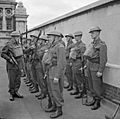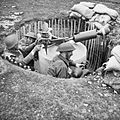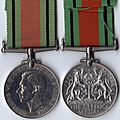British Home Guard facts for kids
The British Home Guard was a special group of volunteers in the British Army during World War II. Their main job was to help defend Britain if Nazi forces tried to invade. They were like a backup defence line.
This group was active from 1940 to 1944. About 1.5 million people joined. These were people who usually couldn't join the regular army, often because they were older. This is why they were sometimes called "Dad's Army." The Home Guard protected Britain's coasts from enemies like paratroopers. They also helped guard important places like factories and airfields. After the war, a popular TV comedy show called Dad's Army made them famous.
How the Home Guard Started
The idea for the Home Guard came partly from Captain Tom Wintringham. After fighting in the Spanish Civil War, he wrote a book about how Britain could create a similar defence group. At first, his ideas weren't fully used because war didn't seem likely.
But things changed, and on May 19, 1940, Anthony Eden, who was in charge of war matters, asked for volunteers on the radio. This new group was first called the Local Defence Volunteers. Their first jobs were more like an armed police force, not direct fighting.
However, the volunteers wanted to do more. So, the government allowed them to "delay and obstruct" enemy attacks. This meant that mostly untrained people, often with older weapons, would face trained enemy soldiers. Later, Prime Minister Winston Churchill pushed for a new name, and the group became known as the Home Guard. If the Nazis had crossed the English Channel, the Home Guard would have fought bravely to slow them down.
Images for kids
-
Lieutenant Percy Reginald Tucker Bermuda Home Guard (with the cap badge of the Bermuda Volunteer Rifle Corps)
-
A Home Guard platoon in 1941. All are equipped with US supplied weapons. The volunteer at the end of the front rank with a Browning Automatic Rifle; the volunteer at the end of the rear rank with a Mark III* Lewis machine gun; accompanied by one volunteer carrying a 47-round ammunition magazine. Other volunteers visible have M1917 Enfield rifles, and the sergeant has a Thompson sub-machine gun
-
Standard Mk II Beaverette II light reconnaissance cars manned by members of the Home Guard in the Scottish Highlands, 14 February 1941.
-
Two Local Defence Volunteers receiving instruction on either a Pattern 1914 or M1917 Enfield rifle. The two Volunteers are wearing the denim overalls over their ordinary clothes, one of them is wearing a collar and tie underneath. Note also the field service caps, the LDV armlets and civilian shoes worn without gaiters. The sergeant instructor is wearing standard battle dress.
-
Home Guard soldiers training with a Blacker Bombard anti-tank mortar in May 1943. The mortar is mounted on a concrete pillar in a pre-prepared pit; of which around 18,000 were dug
-
Lt Gen Lashmer Whistler (General Officer Commanding-in-Chief of the Western Command) with local Home Guard commanders at Oswestry, 1954
-
Zulfiqar Ali Bukhari training with the BBC Home Guard at Bedford College in 1941.
See also
 In Spanish: Home Guard para niños
In Spanish: Home Guard para niños












